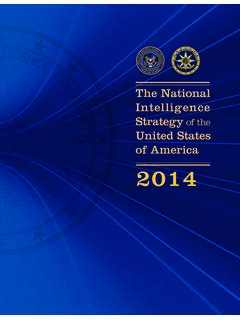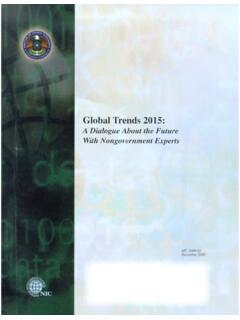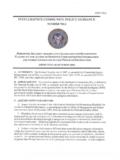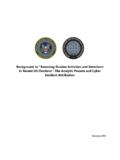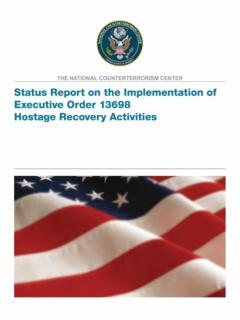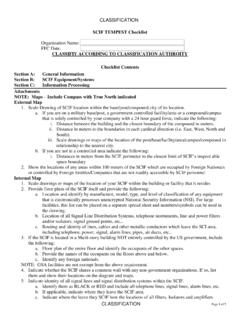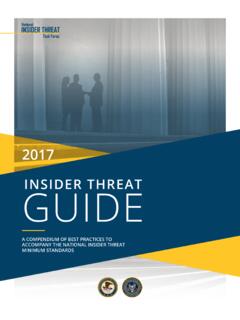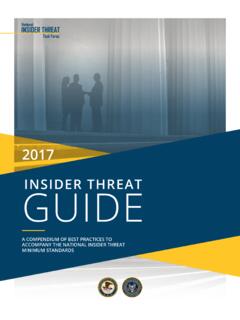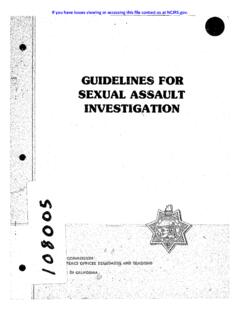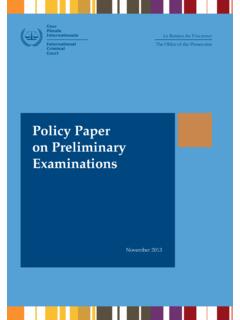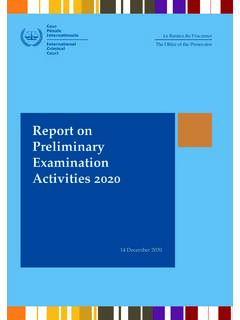Transcription of Preliminary Assessment: Unidentified Aerial Phenomena
1 UNCLASSIFIED UNCLASSIFIED OFFICE OF THE DIRECTOR OF NATIONAL INTELLIGENCE Preliminary Assessment: Unidentified Aerial Phenomena 25 June 2021 UNCLASSIFIED 2 UNCLASSIFIED SCOPE AND ASSUMPTIONS Scope This Preliminary report is provided by the Office of the Director of National Intelligence (ODNI) in response to the provision in Senate Report 116-233, accompanying the Intelligence Authorization Act (IAA) for Fiscal Year 2021, that the DNI, in consultation with the Secretary of Defense (SECDEF), is to submit an intelligence assessment of the threat posed by Unidentified Aerial Phenomena (UAP) and the progress the Department of Defense Unidentified Aerial Phenomena Task Force (UAPTF) has made in understanding this threat. This report provides a n overview for policymakers of the challenges associated with characterizing the potential threat posed by UAP while also providing a means to develop relevant processes, policies, technologies, and training for the military and other Government (USG) personnel i f and when they encounter UAP, so as to enhance the Intelligence Community s (IC) ability to understand the threat.
2 The Director, UAPTF, is the accountable official for ensuring the timely collection and consolidation of data on UAP. The dataset described in this report is currently limited primarily to Government reporting of incidents occurring from November 2004 to March 2021. Data continues to be collected and analyzed. ODNI prepared this report for the Congressional Intelligence and Armed Services Committees. UAPTF and the ODNI National Intelligence Manager for Aviation drafted this report, with input from USD(I&S), DIA, FBI, NRO, NGA, NSA, Air Force, Army, Navy, Navy/ONI, DARPA, FAA, NOAA, NGA, ODNI/NIM-Emerging and Disruptive Technology, ODNI/National Counterintelligence and Security Center, and ODNI/National Intelligence Council. Assumptions Various forms of sensors that register UAP generally operate correctly and capture enough real data to allow initial assessments, but some UAP may be attributable to sensor anomalies.
3 UNCLASSIFIED 3 UNCLASSIFIED EXECUTIVE SUMMARY The limited amount of high-quality reporting on u nidentified Aerial Phenomena (UAP) hampers our ability to draw firm conclusions about the nature or intent of UAP. The Unidentified Aerial Phenomena Task Force (UAPTF) considered a range of information on UAP described in military and IC (Intelligence Community) reporting, but because the reporting lacked sufficient specificity, ultimately recognized that a unique, tailored reporting process was required to provide sufficient data for analysis of UAP events. As a result, the UAPTF concentrated its review on reports that occurred between 2004 and 2021, the majority of which are a result of this new tailored process to better capture UAP events through formalized reporting. Most of the UAP reported probably do represent physical objects given that a majority of UAP were registered across multiple sensors, to include radar, infrared, electro-optical, weapon seekers, and visual observation.
4 In a limited number of incidents, UAP reportedly appeared to exhibit unusual flight characteristics. These observations could be the result of sensor errors, spoofing, or observer misperception and require additional rigorous analysis. There are probably multiple types of UAP requiring different explanations based on the range of appearances and behaviors described in the available reporting. Our analysis of the data supports the construct that if and when individual UAP incidents are resolved they will fall into one of five potential explanatory categories: airborne clutter, natural atmospheric Phenomena , USG or industry developmental programs, foreign adversary systems, and a catchall other bin. UAP clearly pose a safety of flight issue and may pose a challenge to national security. Safety concerns primarily center on aviators contending with an increasingly cluttered air domain.
5 UAP would also represent a national security challenge if they are foreign adversary collection platforms or provide evidence a potential adversary has developed either a breakthrough or disruptive technology. Consistent consolidation of reports from across the federal government, standardized reporting, increased collection and analysis, and a streamlined process for screening all such reports against a broad range of relevant USG data will allow for a more sophisticated analysis of UAP that is likely to deepen our understanding. Some of these steps are resource-intensive and would require additional investment. UNCLASSIFIED 4 UNCLASSIFIED AVAILABLE REPORTING LARGELY INCONCLUSIVE Limited Data Leaves Most UAP Limited data and inconsistency in reporting are key challenges to evaluating UAP. No standardized reporting mechanism existed until the Navy established one in March 2019.
6 The Air Force subsequently adopted that mechanism in November 2020, but it remains limited to USG reporting. The UAPTF regularly heard anecdotally during its research about other observations that occurred but which were never captured in formal or informal reporting by those observers. After carefully considering this information, the UAPTF focused on reports that involved UAP largely witnessed firsthand by military aviators and that were collected from systems we considered to be reliable. These reports describe incidents that occurred between 2004 and 2021, with the majority coming in the last two years as the new reporting mechanism became better known to the military aviation community. We were able to identify one reported UAP with high confidence. In that case, we identified the object as a large, deflating balloon. The others remain unexplained.
7 144 reports originated from USG sources. Of these, 80 reports involved observation with multiple sensors. o Most reports described UAP as objects that interrupted pre-planned training or other military activity. UAP Collection Challenges Sociocultural stigmas and sensor limitations remain obstacles to collecting data on UAP. Although some technical challenges such as how to appropriately filter out radar clutter to ensure safety of flight for military and civilian aircraft are longstanding in the aviation community, while others are unique to the UAP problem set. Narratives from aviators in the operational community and analysts from the military and IC describe disparagement associated with observing UAP, reporting it, or attempting to discuss it with colleagues. Although the effects of these stigmas have lessened as senior members of the scientific, policy, military, and intelligence communities engage on the topic seriously in public, reputational risk may keep many observers silent, complicating scientific pursuit of the topic.
8 The sensors mounted on military platforms are typically designed to fulfill specific missions. As a result, those sensors are not generally suited for identifying UAP. Sensor vantage points and the numbers of sensors concurrently observing an object play substantial roles in distinguishing UAP from known objects and determining whether a UAP demonstrates breakthrough aerospace capabilities. Optical sensors have the benefit of providing some insight into relative size, shape, and structure. Radiofrequency sensors provide more accurate velocity and range information. UNCLASSIFIED 5 UNCLASSIFIED But Some Potential Patterns Do Emerge Although there was wide variability in the reports and the dataset is currently too limited to allow for detailed trend or pattern analysis, there was some clustering of UAP observations regarding shape, size, and, particularly, propulsion.
9 UAP sightings also tended to cluster around training and testing grounds, but we assess that this may result from a collection bias as a result of focused attention, greater numbers of latest-generation sensors operating in those areas, unit expectations, and guidance to report anomalies. And a Handful of UAP Appear to Demonstrate Advanced Technology In 18 incidents, described in 21 reports, observers reported unusual UAP movement patterns or flight characteristics. Some UAP appeared to remain stationary in winds aloft, move against the wind, maneuver abruptly, or move at considerable speed, without discernable means of propulsion. In a small number of cases, military aircraft systems processed radio frequency (RF) energy associated with UAP sightings. The UAPTF holds a small amount of data that appear to show UAP demonstrating acceleration or a degree of signature management.
10 Additional rigorous analysis are necessary by multiple teams or groups of technical experts to determine the nature and validity of these data. We are conducting further analysis to determine if breakthrough technologies were demonstrated. UAP PROBABLY LACK A SINGLE EXPLANATION The UAP documented in this limited dataset demonstrate an array of Aerial behaviors, reinforcing the possibility there are multiple types of UAP requiring different explanations. Our analysis of the data supports the construct that if and when individual UAP incidents are resolved they will fall into one of five potential explanatory categories: airborne clutter, natural atmospheric Phenomena , USG or industry developmental programs, foreign adversary systems, and a catchall other bin. With the exception of the one instance where we determined with high confidence that the reported UAP w as airborne clutter, specifically a deflating balloon, we currently lack sufficient information in our dataset to attribute incidents to specific explanations.
